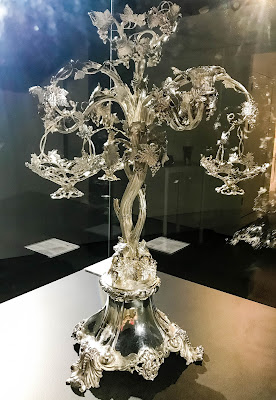When I visited the Orange Regional Museum a couple of years ago, I was struck by this decorative table piece (not literally - it was displayed behind glass). I read that the national Cultural Heritage Account had assisted the museum with the purchase of this item to the tune of $90,000. I thought that was a fair whack for a candlestick, so I read all the information about it - turns out it is quite the icon, so here are the facts, as presented by the museum.
"This sterling silver epergne was presented to David and Amelia Campbell of Goimbla, Eugowra in 1864 by residents of the district to mark their respect and admiration for her role in defending her family's property. The gift was in recognition of the heroism shown by Mrs Campbell and her husband in resisting an attack on their property Goimbla by Ben Hall, Johnny Gilbert, and John O'Meally. The bushrangers attacked the property and set the Campbell's barn and stables on fire. O'Meally was killed in the attack.
The epergne is a decorative table centrepiece which stands 72cm high and was made in London in 1862 by Thomas Smily. The epergne was purchased from Hardy Brothers Sydney for £150 with funds raised by community subscriptions. Modelled in a rococo revival style, the epergne has a tri-form base with leaf feet, scrolls and beading, rising to a naturalistic trunk with six scrolling arms, three with candle fittings and three supporting loop-handled baskets with a centre basket. The entire epergne is ornately decorated with vines and grapes.
Although the inscription is to both David and Amelia Campbell, contemporary accounts of the presentation event describe Mr Campbell being given a gold watch, now in the State Library of NSW, while the epergne was a gift to Mrs Campbell along with a silver-plated coffee urn inscribed by the ladies of Upper and Middle Adelong, and a printed silk address signed by 92 male residents of Forbes and District. The presentation of these lavish gifts was made at Goimbla in October 1864.
 |
| David and Amelia Campbell (taken from a lantern slide: National Museum of Australia) |
Approximately 16 gold and silver bushranger medals were presented to police and members of the public to mark their heroism during encounters with bushrangers. This is the only presentation-epergne associated with bushranger attacks and the only presentation made to a woman. Its delicacy of design and execution has a particularly feminine character.
Amelia Campbell was lauded as a 'daughter of Australia - a lady brought up and educated in Sydney who did not flinch under gunfire.'
Her heroism is emblematic of the often-overlooked dangers of many women living on lonely farms in regional Australia. Sadly, other women who stood their ground and fended off attacks by bushrangers received little public recognition. This epergne represents an important aspect of Australian colonial history and is one of the most notable and significant items of nineteenth-century Australian women's history."
 |
| Ben Hall |



No comments:
Post a Comment